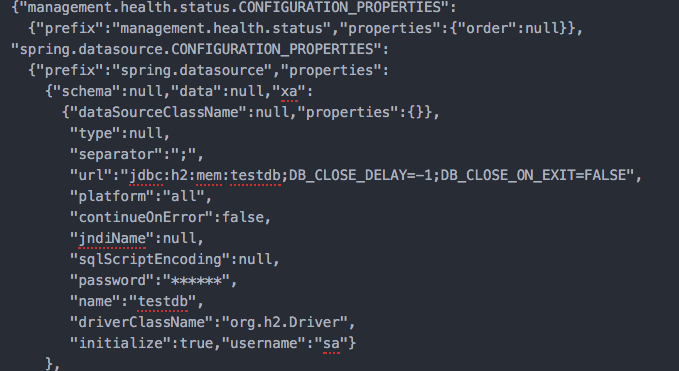spring-boot-starter-parent
A special starter that provides useful maven defaults. It also provides a dependency-management section so that you can omit version tags for common dependencies. Spring-boot-starter-parent includes a few of maven goal such as repackage and run goal to start application:
mvn spring-boot:run
Other features can be found from here.
Overview Spring Boot
- Automatic configuration
- Starter dependencies
- Command line interface
- The actuator
Configuration
Spring boot read the properties based on the sequence which overwrite from top down sequence. Eg, default properties can get overwritten by any 1-7 options.
- Command line argues
- JNDI lookup
- JVM system properties
- OS system environment variable
- external application.properties (subdir /config or same level path as application)
- internal application.properties (not the default path, package named “config” or root classpath)
- Property sources specific by @PropertySource
- default properties
Profile and properties file
application.properties file are serve as default properties file. If you’d like to have properties file based on different profile setting. Let’s say production, staging, development. All you need to do is create the properties file with this pattern. application-{profile}.properties. And activate the profile during your application startup.
@ConfigurationProperties
With annotated @ConfigurationProperties, your bean class it has injected a value (setter injection) with prefixed define by your choice, Let’s say ‘hello‘. It similar like using @Value inject from properties files.
1) First you’ve need to add the dependencies.
<dependency> <groupId>org.springframework.boot</groupId> <artifactId>spring-boot-configuration-processor</artifactId> <optional>true</optional> </dependency>
2) Example, in controller annotated @ConfigurationProperties. We can specific the location file with attribute as well.
(more practically, use it as a component class and inject to your controller)
@Controller
@RequestMapping("/hello")
@ConfigurationProperties(prefix="hello")
public class HelloWorldController {
private String world;
public void setWorld(String world) {
this.world = world;
}
@RequestMapping(method = RequestMethod.GET)
public String index(Model model) {
model.addAttribute("world", world);
return "helloworld";
}
}
3 Properties file
hello.world=Hello World
4. Your html
<!DOCTYPE html>
<html xmlns:th="http://www.thymeleaf.org">
<head>
<title>Reading List</title>
<link rel="stylesheet" th:href="@{/css/style.css}"></link>
</head>
<body>
<h2>Hello World</h2>
<p th:text="${world}">Text to be replace</p>
</body>
</html>
Web Resource Version Random Hash
# Appended random hash string behind the resources files. spring.resources.chain.strategy.content.enabled=true spring.resources.chain.strategy.content.paths=/**

Web Resource Version Append
spring.resources.chain.strategy.fixed.enabled=true spring.resources.chain.strategy.fixed.paths=/** spring.resources.chain.strategy.fixed.version=v1

Web Resource Compression GZIP
server.compression.enabled=true server.compression.min-response-size=0
Web Context Path
From the application.properties modified the follow properties. After that you’ll able access with http://web:8080/app
server.address=web server.port=8081 server.context-path=/app
Actuator
Actuator is a feature provided by spring boot to let you inspect in your spring boot application. Actuator provide service such as monitoring and metric to the application. There are several way to gain the data either through the remote endpoint with REST, remote shell and JMX.
GET /autoconfig
A report describing about autoconfig condition either pass or failed.

GET /configprops
A report to show how exactly a bean injected with configuration properties

Get /beans
A report to show all the beans in relationship

Get /dump
Snapshoot dump of thread activity

Get /health
An application health check. It can be configured from application.properties with showing details or without.
endpoints.health.sensitive=[true/false]

Health Indicator
We can create custom health check by implement HealthIndicator interface. It will output to actuator.
public class WebserviceHealIndicator implements HealthIndicator
{
public Health health() {
boolean good = true;
//implement logic ping your remote
if (true) {
return Health.up().withDetail("Webservice up", "Connection alive").build();
} else {
return Health.down().withDetail("Webservice down","Connection lost").build();
}
}
}
Actuator Info
By default, actuator expose nothing on the info. But you can provide the information with the following properties. Alternative, by using @[value]@ to refer the properties set from maven pom.xml
info.appname=Hello info.framework=Springboot info.artifact=@project.artifactId@ info.name=@project.name@ info.java.version=@java.version@
Output:
{"appname":"Hello","framework":"Springboot","name":"s-secure","artifact":"webapp","java":{"version":"1.8.0_20"}}
And more others like
- Get /env or /env/{name}
- Get /info
- Get /mappings
- Get /metrics or /metrics/{name}
- Get /shutdown
- Get /trace
Interface upon startup
- CommandLineRunner
- ApplicationRunner
Create Filter
- Create filter and annotated with @Component or @WebFilter
- Annotation with @ServletComponentScan.
Customize actuator path
From the application.properties, modified the value. http://localhost:8080/privat/aconfig
managment.context-path=/private endpoints.autoconfig.path=/aconfig